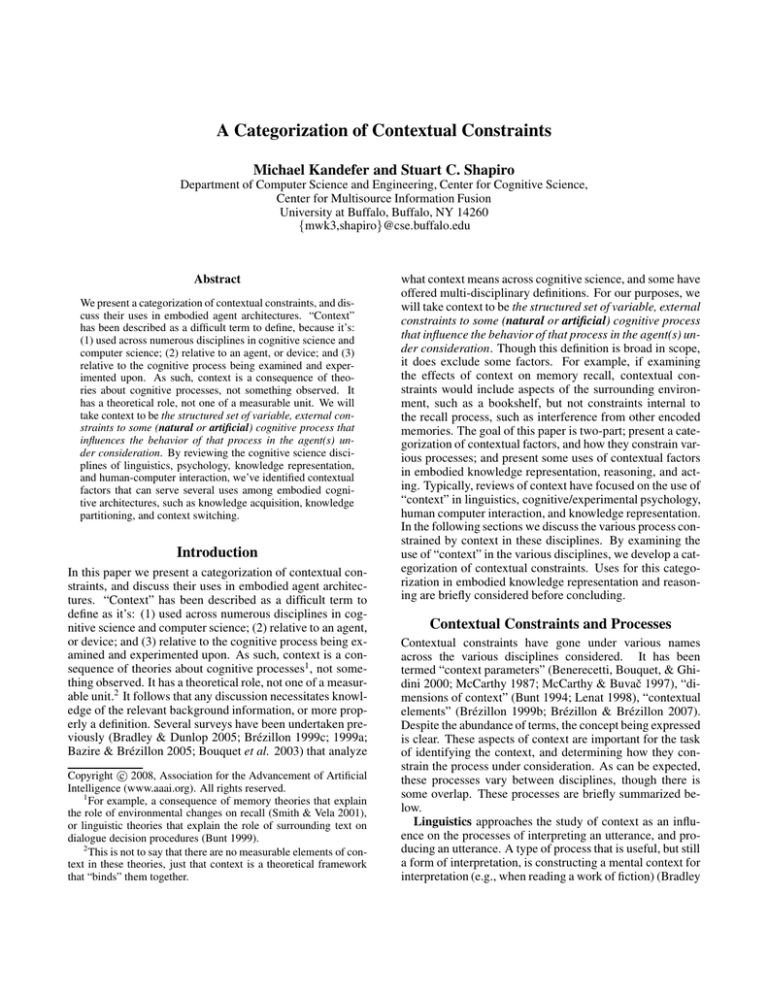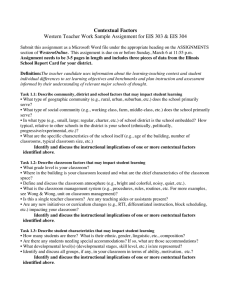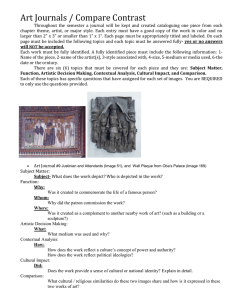
A Categorization of Contextual Constraints
Michael Kandefer and Stuart C. Shapiro
Department of Computer Science and Engineering, Center for Cognitive Science,
Center for Multisource Information Fusion
University at Buffalo, Buffalo, NY 14260
{mwk3,shapiro}@cse.buffalo.edu
Abstract
We present a categorization of contextual constraints, and discuss their uses in embodied agent architectures. “Context”
has been described as a difficult term to define, because it’s:
(1) used across numerous disciplines in cognitive science and
computer science; (2) relative to an agent, or device; and (3)
relative to the cognitive process being examined and experimented upon. As such, context is a consequence of theories about cognitive processes, not something observed. It
has a theoretical role, not one of a measurable unit. We will
take context to be the structured set of variable, external constraints to some (natural or artificial) cognitive process that
influences the behavior of that process in the agent(s) under consideration. By reviewing the cognitive science disciplines of linguistics, psychology, knowledge representation,
and human-computer interaction, we’ve identified contextual
factors that can serve several uses among embodied cognitive architectures, such as knowledge acquisition, knowledge
partitioning, and context switching.
Introduction
In this paper we present a categorization of contextual constraints, and discuss their uses in embodied agent architectures. “Context” has been described as a difficult term to
define as it’s: (1) used across numerous disciplines in cognitive science and computer science; (2) relative to an agent,
or device; and (3) relative to the cognitive process being examined and experimented upon. As such, context is a consequence of theories about cognitive processes1 , not something observed. It has a theoretical role, not one of a measurable unit.2 It follows that any discussion necessitates knowledge of the relevant background information, or more properly a definition. Several surveys have been undertaken previously (Bradley & Dunlop 2005; Brézillon 1999c; 1999a;
Bazire & Brézillon 2005; Bouquet et al. 2003) that analyze
c 2008, Association for the Advancement of Artificial
Copyright Intelligence (www.aaai.org). All rights reserved.
1
For example, a consequence of memory theories that explain
the role of environmental changes on recall (Smith & Vela 2001),
or linguistic theories that explain the role of surrounding text on
dialogue decision procedures (Bunt 1999).
2
This is not to say that there are no measurable elements of context in these theories, just that context is a theoretical framework
that “binds” them together.
what context means across cognitive science, and some have
offered multi-disciplinary definitions. For our purposes, we
will take context to be the structured set of variable, external
constraints to some (natural or artificial) cognitive process
that influence the behavior of that process in the agent(s) under consideration. Though this definition is broad in scope,
it does exclude some factors. For example, if examining
the effects of context on memory recall, contextual constraints would include aspects of the surrounding environment, such as a bookshelf, but not constraints internal to
the recall process, such as interference from other encoded
memories. The goal of this paper is two-part; present a categorization of contextual factors, and how they constrain various processes; and present some uses of contextual factors
in embodied knowledge representation, reasoning, and acting. Typically, reviews of context have focused on the use of
“context” in linguistics, cognitive/experimental psychology,
human computer interaction, and knowledge representation.
In the following sections we discuss the various process constrained by context in these disciplines. By examining the
use of “context” in the various disciplines, we develop a categorization of contextual constraints. Uses for this categorization in embodied knowledge representation and reasoning are briefly considered before concluding.
Contextual Constraints and Processes
Contextual constraints have gone under various names
across the various disciplines considered. It has been
termed “context parameters” (Benerecetti, Bouquet, & Ghidini 2000; McCarthy 1987; McCarthy & Buvač 1997), “dimensions of context” (Bunt 1994; Lenat 1998), “contextual
elements” (Brézillon 1999b; Brézillon & Brézillon 2007).
Despite the abundance of terms, the concept being expressed
is clear. These aspects of context are important for the task
of identifying the context, and determining how they constrain the process under consideration. As can be expected,
these processes vary between disciplines, though there is
some overlap. These processes are briefly summarized below.
Linguistics approaches the study of context as an influence on the processes of interpreting an utterance, and producing an utterance. A type of process that is useful, but still
a form of interpretation, is constructing a mental context for
interpretation (e.g., when reading a work of fiction) (Bradley
& Dunlop 2005).
Cognitive and experimental psychology, hereafter,
“psychology”, examines contextual influence on the cognitive processes, such as perception, learning, and memory
(Bradley & Dunlop 2005). While each of these is a process
of its own, the interplay of each process can fall under the
general process, cognition. In this sense, each cognitive process can act as a constraint on another cognitive process, and
thus, the former is a contextual constraint on the latter. This
notion is exemplified in experiments that study the influence
of environment on the recall process (Godden & Baddeley 1975; Smith & Vela 2001), and those that demonstrate
the effects of mental reinstate of environment, demonstrating how another cognitive process, namely “imagination”,
can serve as a constraint on the recall process (Smith 1979;
Smith & Vela 2001).
Human computer interaction (HCI) examines the influence of contextual constraints on computational devices
that interact with a user. This research endeavor falls under the broad category of “context-aware computing”, which
uses context to provide relevant services and information to
a user (Dey 2001). Typical processes in HCI include: user
preference learning and selection, autobiographical construction, providing relevant information based on context,
and relevant operations (Dey 2001; Chen & Kotz 2000;
Bradley & Dunlop 2005).
Knowledge representation and reasoning (KRR) seeks
to formalize context, a need that grew out of the identification of the problem of generality, which is essentially the
notion that any representation of knowledge can be criticized as eliminating some influential properties useful to
other domains not (yet) represented in the current knowledge base (McCarthy 1987). As such, one process that
context can constrain is the process of representation itself,3 where the context determines how general or specific a logical representation can be. Furthermore, the process of developing the logic used for reasoning is also constrained by contextual aspects, such as: the locality of logical semantics and syntax, and a priori considerations that
effect initial relationships between contexts (Buvač 1996;
Benerecetti, Bouquet, & Ghidini 2000; Bouquet et al. 2003).
Other processes that can be constrained by context in
KRR include; knowledge acquisition (Brézillon 1999c;
1999a), large-scale knowledge base partitioning (Bouquet et
al. 2003; Brézillon 1999b; Lenat 1998), providing relevant
information (Arritt & Turner 2003), and providing semantic
interpretation (Brézillon 1999b).
A Categorization of Contextual Constraints
The cognitive processes discussed in the previous section
can aid in the elicitation of a general categorization of contextual constraints. Though the processes vary between the
disciplines considered, there is much overlap in the contextual constraints utilized in recognizing and using context
among them. The top-level of the categorization is depicted
3
More appropriately, this can be viewed as constraining the
memory encoding process of some agent, though a knowledge engineer is performing the encoding process.
Figure 1: The Top-level of Contextual Constraints
in Fig. 1,4 with arrows indicating subclass-superclass directionality. The various “levels” of this categorization, how
these factors are viewed in the independent disciplines, if
at all, and typical instantiations of them as discussed below. However, this categorization serves as an overview of
constraints discussed in the field, without getting into too
specific details (e.g., the categorization stops at “events” in
the “external” subtree. We can easily categorize more event
types, such as weather systems).
The External-Internal Dichotomy
If context is the set of constraints external to some cognitive
process, as we claim, it might seem contrary to the proposed
definition to consider contextual constraints that are internal. Furthermore, “context” is often used synonymously
with the environment, arguably the all-encompassing external constraint. Despite these intuitions, the literature does
make a distinction between contextual constraints that are
external or internal to an agent “executing” the process constrained. These two constraints can go under numerous
pseudonyms,5 but denote the same categories of constraints.
In linguistic processes, like CVA,6 a distinction is placed
between external contextual sources, like dictionaries and
the words themselves, and the reader’s internal “prior
knowledge” (Rapaport 2005). Internal and external constraints have also been found to play a role in the dialogue control processes, called, by Bunt, the “cognitive
context” (which contains background beliefs, intentions,
and plans) and “physical context” respectively (Bunt 1994;
1999).
In a brief review of psychology literature on context,
Bradley and Dunlop (2005) present a distinction between
the two, “[external] context would be the situation or environment the person is in, and the internal context would
be the internal knowledge/mechanisms underlying the person’s cognitive processes (e.g., mood, state-dependent effects)”. Consistent distinctions are made by Smith (1979;
2001) in the psychological memory literature.
In HCI, Gwizdka (2000) introduces a context model for
context-aware applications that makes a clear distinction between “internal context”, which takes into account the user’s
4
Hierarchy constructed using Topbraid (Top Quadrant Inc.
2007)
5
As is the case for many of the categories considered in the
categorization.
6
A process of determining word meaning from surrounding text
and background knowledge.
Figure 2: The External Contextual Constraints
state, and “external context”, which includes factors external
to the user. The concept of using the user’s internal state and
physical environment as a constraint for devices is prevalent
in the HCI literature (Abowd et al. 1999; Chen & Kotz 2000;
Dey 2001; Bradley & Dunlop 2005).
Finally, in KRR, most work has concerned itself with
constraints placed on the representation of the knowledge
itself,7 and typically these constraints, or parameters, are
external in nature. Part of this can be attributed to the notion that knowledge bases aren’t always treated as embodied
agents but rather disembodied, logical databases. However,
not all proposed uses for contextual parameters are divorced
from internal constraints. McCarthy and Buvač (1997), propose a use for contextual parameters as justification for belief in propositions, where the agent’s internal rationality for
believing all the propositions in a context is a parameter. In
(Brézillon 2005) three types of knowledge involved in context are proposed, one of which, named “contextual knowledge”, is said to “[depend] on the actor and the decision at
hand”. Here, a decision can be considered an internal constraint.
It’s clear from the previous that there is a distinction between internal and external contextual constraints that appears when considering the perspective of an agent or device. Since context, as we’ve defined it, is considered relative to both a process and an agent or device executing that
process, all contextual factors will fall into either category
when both a particular agent/device and process are taken
into consideration. The following sections will discuss the
type of constraints that emerge in both categories when considering particular agents, and cognitive process.
External Constraints
While all of the disciplines discussed have constraints external to the processes considered, the constraints that fall
into this category vary between disciplines. We’ve identified three general categories of external constraints depicted
in Fig. 2.
Environmental constraints are discussed across all disciplines, and sometimes it’s taken to be synonymous with context (Dey 2001). However, what is typically regarded as a
type of environmental constraint varies. In linguistics, Bunt
(1999; 1994) has developed a model of dialogue control that
incorporates a “physical/perceptual context” that includes
the environmental constraints discussed above. The “physi-
cal context” is divided into “global” constraints, which include spatial and temporal constraints; and “local” constraints, which include the people or agents involved in the
dialogue. Bradley and Dunlop (2005) describe similar models in the area of linguistic “situation theory”.
In psychology, all of the environmental constraints appear
as influential to the variety of cognitive processes. Most notably are studies involving memory. Godden and Baddeley
(1975) demonstrate that individuals tested in the same environment that they learned the information have superior
recall of that information, showing the spatial effects of context on memory recall. Such studies were expanded to show
improved ability when physical objects (Smith 1979), and
experimenter (Smith & Vela 2001), a person, were the same.
Finally, Anderson (2007b) notes the importance of temporal
recency of learned material in recall when combined with
spatial factors.
Similar to psychology, KRR has incorporated environmental constraints as parameters to the sets of axioms that
represent a “context”. Lenat (1998) has contributed twelve
such constraints, among those are absolute time/space,
which are specific spatio-temporal values (e.g. Mike’s Office at 12:00pm); and Type of time/space, which are general
spatio-temporal locations (e.g. in bed at bedtime). The use
of time is also supported by McCarthy’s (1997) contextualized blocks world example, while the use of people is introduced through his use of ‘Holmes’ as a concept needing
interpretation in context8. In (Benerecetti, Bouquet, & Ghidini 2000) people are utilized to provide interpretation for
indexicals.
All of these environmental constraints are discussed in the
HCI literature. The inclusion of people is hardly surprising, since many applications are meant to provide services
customized for the user using them (Abowd et al. 1999;
Dey 2001; Dourish 2004). Spatial, sometimes called “physical”, and time constraints are also discussed frequently
(Chen & Kotz 2000). HCI also considers events and actions as constraints. Intuitively, these are spatial and temporal, and as such, they are classified as a subcategory of both
space and time.
HCI is unique from the other disciplines in that it also
considers informational constraints, or the computing context. These include information about services available
to a device in question. Such information can include
local printing services, workstations, network connectivity, and communication costs (Lamming & Flynn 1994;
Chen & Kotz 2000). In general, informational constraints
are dependent on data sources, and capable of being sensed
and interpreted by the agent or device in question.
Finally, linguistic constraints are, unsurprisingly, seen in
the linguistics, but also in AI applications, such as CVA (Rapaport 2005). Important to the discussion of context in linguistics is the concept of cotext, which is the text that surrounds a unit of language (e.g. words, phrases, etc), and
intertext the external information sources that are required
for interpretation (e.g. dictionaries, books, etc.) (Bradley &
7
Though “why” these constraints are placed is subject to the
numerous proposed uses for context in KR (c.f. Uses in Embodied
Knowledge Representation and Reasoning).
8
More correctly a fictional and real individual named ’Holmes’
are used as a constraint, though both are people.
Figure 3: The Internal Contextual Constraints
Dunlop 2005; Rapaport 2005). With this in mind linguistic constraints can be categorized as spoken cotext, spoken
intertext, textual cotext, or textual intertext. As can be expected cotext can come from two sources, the spoken variety or the textual variety (Bunt 1994). Intuitively, this notion isn’t extended to intertext as previous spoken dialogues
required for interpretation would be a part of an agent’s internalized memory (c.f., Internal Constraints).
That some external constraints, such as informational,
can be found in some of the disciplines, and not in others
shouldn’t suggest that these constraints aren’t useful in the
others. Nor should it indicate that these constraints should
be excluded from a theoretical model, or application that
wants to make the greatest use of context. Rather, it’s further
evidence that context is relative to the process and agent executing the process. For example, HCI processes that provide
relevant information about the network environment have no
need for the spoken cotext or intertext constraints, while a
cognitive architecture modeling communication would.
Internal Constraints
The internal constraints (depicted in Fig. 3) are split among
among two subcategories. Though not typically considered
contextual factors, system resources act as constraints to the
computation underlying processes, as do the sensory capabilities of the devices themselves, and thus fit the initial definition for context provided. However, when internal constraints are mentioned in the HCI literature, it’s usually in
consideration of the user’s mental state (c.f., The ExternalInternal Dichotomy).
The cognitive side of the internal category is largely dominated by the linguistics and psychology fields. There are
three primary cognitive aspects that can constrain other cognitive processes; memory, intentions, and imagination.
In linguistics, the contents of an individual’s memory play
an important role in linguistics as they allow the user to bring
to bear appropriate contextual information when interpreting (Bradley & Dunlop 2005). The role of memory is also
important to CVA (Rapaport 2005), where “personal knowledge” is used to make inferences about potential word meaning. Bunt (1994; 1999) includes cognitive constraints in his
dialogue control model, which includes memory as well as
intentions and other cognitive attitudes.
In psychology, learned concepts in memory and behaviors can result in effects on other cognitive systems, such
as vision, where familiarity with an object can increase object recognition times. Memory studies once again provide
a useful source for contextual factors. In (Smith & Vela
2001) one of the hypotheses tested was the mental reinstatement of an environment. The use of imagination to visualize an environment where a particular information item was
learned, causes that item to be recalled easier. Finally, cognitive models, like ACT-R (Anderson 2007a), integrate several cognitive modules, like intentionality and memory, each
constraining the activities of others in order to better approximate cognitive functionality.
As was the case with the external constraints, the internal
constraints do not occur across all disciplines. However, this
is mostly due to the difference in the processing unit under
consideration. One one side of the category we have human
cognition, the other side deals with device internals. Though
it should be observed that some metaphorical parallels can
occur, such as between RAM, and human memory.
Uses in Embodied Knowledge Representation
and Reasoning
Embodied cognitive architectures (Kandefer & Shapiro
2007; Hexmoor, Lammens, & Shapiro 1993; Wray & Jones
2005; Anderson 2005) can benefit from the (conscious or
unconscious) recognition and utilization of contextual constraints. The possibilities are probably as numerous as there
are cognitive processes influenced by context, but three general categories include:
Knowledge-base partitioning
Large-scale knowledge bases, such as Cyc (Lenat & Guha
1989), can grow to unmanageable sizes, where reasoning is
hindered by the vast number of propositions that need to be
considered. Also due to the size of such repositories, contradictions can be introduced easily by knowledge engineers.
As such, Cyc has split its knowledge base into partitioned
belief spaces, called “microtheories”. However, how to determine which belief space a proposition belongs to requires
a method of indexing. Lenat (Lenat 1998) has proposed
twelve dimensions for indexing his “microtheories”. While
many of these twelve dimensions are considered in the contextual constraint categorization above, some of Lenat’s appear custom tailored for Cyc’s considerations, and not general embodied architectures (which, to be fair, Cyc isn’t).
Through the use of such indexing, knowledge engineers can
specify where in the KB a proposition belongs by specifying values for any number of the constraint slots (or dimensions), thus, partitioning the knowledge base as it’s built.
Contextual Knowledge Acquisition
Knowledge acquisition can be contextualized with the above
context factors. If cognitive architectures can recognize
certain contextual constraints in their environment, coupled
with the contextual constraints in the information they are
acquiring, contexts can be constructed automatically by the
architecture, instead of relying on a knowledge engineer to
place the information in the correct belief space. This is similar to knowledge partitioning, except, rather than taking a
large KB and divvying it up, an agent automatically handles
the assignment of knowledge to a context as it is learned.
A formal logic system that takes into account the contextual
background knowledge of an agent coupled with new information being introduced to it, in order to determine where
the information belongs, if anywhere, has been proposed in
(Sperber & Wilson 1995).
Context Swapping
A “relevancy problem” can be addressed through the use of
such factors. The relevancy problem is defined by Ekbia
and Maguitman (Ekbia & Maguitman 2001) as “the problem of identifying and using properly [only] the information that should exert an influence on our beliefs, goals, or
plans”. In their paper they discuss the “Pragmatic View
of Context” (a theory of context posited by John Dewey)
and, more importantly, the necessity of context to relevancy.
One methodology for solving this problem is to index belief spaces with contextual constraints, and then swap in relevant belief spaces when external or internal “cues” align
with those indices.
Similar systems have been proposed that address the relevancy problem using contextual constraints, such as the
context-based, logic system developed for information communication discussed in (Sperber & Wilson 1995). This system takes new information entering it, couples that with the
existing working knowledge, and from that determines the
relevancy of the current working knowledge to the input. If
the current working knowledge isn’t relevant, then a new
belief set can be swapped in as working knowledge. Similarly, a system for analyzing perceptual information and using that to “diagnose” the situation, and bring to bear appropriate contextual information for that situation in underwater
exploration vehicles has been proposed in (Arritt & Turner
2003).
Conclusions
A categorization of contextual constraints was constructed
from a review of the cognitive science literature. This categorization provides useful “parameters” for divvying knowledge into belief spaces, encoding information in the correct
belief space, and bringing relevant belief space(s) to bear
given contextual “cues”. Though many of the constraints included in the architecture were found across all disciplines,
some remained unique to their respective disciplines, in particular HCI had internal constraints that included system resources, and external constraints that involved data available
to the devices in question. Such distinctions are notable as
they support the view that context is relative to a process,
and the agents or device under consideration.
References
Abowd, G. D.; Dey, A. K.; Brown, P. J.; Davies, N.; Smith,
M.; and Steggles, P. 1999. Towards a better understanding
of context and context-awareness. In HUC ’99: Proceedings of the 1st international symposium on Handheld and
Ubiquitous Computing, 304–307. London, UK: SpringerVerlag.
Anderson, J. R. 2005. Human symbol manipulation within
an integrated cognitive architecture. Cognitive Science
29(3):313–341.
Anderson, J. R. 2007a. Chapter 1: Cognitive architecture.
In How Can the Human Mind Occur in the Physical Universe? NY, New York: Oxford University Press. 3–43.
Anderson, J. R. 2007b. Chapter 3: Human associative
memory. In How Can the Human Mind Occur in the Physical Universe? NY, New York: Oxford University Press.
91–134.
Arritt, R., and Turner, R. 2003. Situation assessment for
autonomous underwater vehicles using a priori contextual
knowledge. In Proceedings of the Thirteenth International
Symposium on Unmanned Untethered Submersible Technology (UUST).
Bazire, M., and Brézillon, P. 2005. Understanding context
before using it. In Modeling and Using Context. 5th International and Interdisciplinary Conference, CONTEXT
2005, 29–40.
Benerecetti, M.; Bouquet, P.; and Ghidini, C. 2000. Contextual reasoning distilled. JETAI 12(3):279–305.
Bouquet, P.; Ghidini, C.; Giunchiglia, F.; and Blanzieri, E.
2003. Theories and uses of context in knowledge representation and reasoning. Journal of Pragmatics 35(3):455–
484.
Bradley, N. A., and Dunlop, M. D. 2005. Toward
a multidisciplinary model of context to support contextaware computing. HUMAN-COMPUTER INTERACTION
20:403–446.
Brézillon, J., and Brézillon, P. 2007. Context Modeling:
Context as a Dressing of a Focus. In Modeling and Using
Context: 6th International and Interdisciplinary Conference, CONTEXT 2007, 136–149.
Brézillon, P. 1999a. Context in artificial intelligence: I. a
survey of the literature. Computer & Artificial Intelligence
18(4):321–340.
Brézillon, P. 1999b. Context in Artificial Intelligence: II.
Key elements of contexts. Computer & Artificial Intelligence 18(5):425–446.
Brézillon, P. 1999c. Context in problem solving: a survey.
The Knowledge Engineering Review 14:47–80.
Brézillon, P. 2005. Task-Realization Models in Contextual
Graphs. In Modeling and Using Context. 5th International
and Interdisciplinary Conference, CONTEXT 2005, 55–66.
Bunt, H. C. 1994. Context and dialogue control. THINK
Quarterly 3:19–31.
Bunt, H. 1999. Context representation for dialogue management. In CONTEXT ’99: Proceedings of the Second International and Interdisciplinary Conference on Modeling
and Using Context, 77–90. London, UK: Springer-Verlag.
Buvač, S. 1996. Quantificational logic of context. In
AAAI/IAAI, Vol. 1, 600–606.
Chen, G., and Kotz, D. 2000. A survey of context-aware
mobile computing research. Technical Report TR2000381, Dept. of Computer Science, Dartmouth College.
Dey, A. K. 2001. Understanding and using context. Personal and Ubiquitous Computing 5(1):4–7.
Dourish, P. 2004. What we talk about when we talk about
context. Personal Ubiquitous Computing 8(1):19–30.
Ekbia, H. R., and Maguitman, A. G. 2001. Context and relevance: A pragmatic approach. Lecture Notes in Computer
Science 2116:156–169.
Godden, D., and Baddeley, A. 1975. Context-dependent
memory in two natural environments: on land and underwater. British Journal of Psychology 66:325–332.
Gwizdka, J. 2000. What’s in the Context? Position paper
for workshop on The What, Who, Where, When, Why and
How of Context-Awareness. CHI’2000.
Hexmoor, H.; Lammens, J.; and Shapiro, S. C. 1993. Embodiment in GLAIR: a grounded layered architecture with
integrated reasoning for autonomous agents. In II, D. D. D.,
and Stewman, J., eds., Proceedings of The Sixth Florida AI
Research Symposium (FLAIRS 93), 325-329. Florida AI
Research Society.
Kandefer, M., and Shapiro, S. 2007. Knowledge acquisition by an intelligent acting agent. In Amir, E.; Lifschitz,
V.; and Miller, R., eds., Logical Formalizations of Commonsense Reasoning, Papers from the AAAI Spring Symposium Technical Report SS-07-05, 77–82. AAAI Press,
Menlo Park, CA.
Lamming, M., and Flynn, M. 1994. Forget-me-not: intimate computing in support of human memory. In Proceedings FRIEND21 Symposium on Next Generation Human
Interfaces.
Lenat, D. B., and Guha, R. V. 1989. Building Large
Knowledge-Based Systems; Representation and Inference
in the Cyc Project. Boston, MA, USA: Addison-Wesley
Longman Publishing Co., Inc.
Lenat, D. 1998. The Dimensions of Context Space. Technical report, Cycorp.
McCarthy, J., and Buvač, S. 1997. Formalizing context
(expanded notes). In Buvač, S., and Iwańska, Ł., eds.,
Working Papers of the AAAI Fall Symposium on Context
in Knowledge Representation and Natural Language, 99–
135. Menlo Park, California: American Association for
Artificial Intelligence.
McCarthy, J. 1987. Generality in artificial intelligence.
Communications of the ACM 30(12):1030–1035.
Rapaport, W. 2005. In defense of contextual vocabulary
acquisition. In Modeling and Using Context. 5th International and Interdisciplinary Conference, CONTEXT 2005,
396–409.
Smith, S., and Vela, E. 2001. Environmental contextdependent memory. Psychonomic Bulletin & Review
8(2):203–220.
Smith, S. 1979. Remembering in and out of context. Journal of Emperimental Psychology: Human Learning and
Memory 5:460–471.
Sperber, D., and Wilson, D. 1995. Relevance: Communication and Cognition. Blackwell Publishing, Malden, MA.
Top Quadrant Inc.
2007.
Topbraid Composer.
www.topbraidcomposer.com/.
Wray, R., and Jones, R. 2005. Considering soar as an agent
architecture. In Sun, R., ed., Cognition and Multi-agent
Interaction. Cambridge University Press. 53–78.





